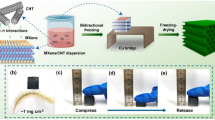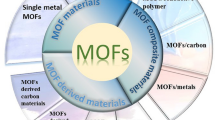Abstract
Using the mesophase pitch as precursor, KOH and CO2 as activated agents, the activated carbon electrode material was fabricated by physical-chemical combined activated technique for supercapacitor. The influence of activated process on the pore structure of activated carbon was analyzed and 14 F supercapacitor with working voltage of 2.5 V was prepared. The charge and discharge behaviors, the properties of cyclic voltammetry, specific capacitance, equivalent serials resistance (ESR), cycle properties, and temperature properties of prepared supercapacitor were examined. The cyclic voltammetry curve results indicate that the carbon based supercapacitor using the self-made activated carbon as electrode materials shows the desired capacitance properties. In 1 mol/L Et4NBF4/AN electrolyte, the capacitance and ESR of the supercapacitor are 14.7 F and 60 mΩ, respectively. The specific capacitance of activated carbon electrode materials is 99.6 F/g; its energy density can reach 2.96 W·h/kg under the large current discharge condition. There is no obvious capacitance decay that can be observed after 5000 cycles. The leakage current is below 0.2 mA after keeping the voltage at 2.5 V for 1 h. Meanwhile, the supercapacitor shows desired temperature property; it can be operated normally in the temperature ranging from −40 °C to 70 °C.
Similar content being viewed by others
References
KOTZ R, CARLEN M. Principle and application of electrochemical capacitors[J]. Electrochimica Acta, 2000, 54(11): 2483–2498.
BONNEFOI L, SIMON P, FAUVARQUE J F, et al. Electrode optimisation for carbon power supercapacitors[J]. Power Source, 1999, 87(2): 1113–1119.
WANG Xiao-feng, RUAN Dian-bo, WANG Da-zhi. Hybrid electrochemical supercapacitors based on polyaniline and activated carbon electrodes[J]. Acta Phys Chim Sin, 2005, 21(3): 261–266.
LAI Yan-qing, LI Jing, LI Jie, et al. Preparation and electrochemical characterization of C/PANI composite electrode materials[J]. Journal of Central South University of Technology, 2006, 13(4): 353–359.
LI Jing, LI Jie, LAI Yan-qing, et al. Influence of KOH activation techniques on pore structure and electrochemical property of carbon electrode materials[J]. Journal of Central South University of Technology, 2006, 13(4): 360–366.
VIX-GUTERL C, SAADALLAH S. supercapacitor electrodes from new ordered porous carbon materials obtained by a template procedure[J]. Materials Science and Engineering B, 2004, B108(2): 148–155.
WANG Yong-gang, ZHANG Xiao-gang. Preparation and electrochemical capacitance of RuO2/TiO2 nanotubes composites[J]. Electrochemical Acta, 2004, 49(12): 1957–1962.
PEDRO G R, MALGORZATA C, KARINA C G, et al. Hybrid organic-inorganic nanocomposite materials for application in solid-state electrochemical supercapacitors[J]. Electrochemistry Communications, 2003, 5(2): 149–153.
CONWAY B F. Transition from “supercapacitor” to “battery” behavior in electrochemical energy storage[J]. Journal of Electrochemical Society, 1991, 6(1): 1439–1448.
PASSERINI V, VIDAKOVIC T, DEKANSKI A, et al. The properties of carbon-supported hydrous ruthenium oxide obtained from RuOxHy sol[J]. Electrochimica Acta, 2003, 48(25/26): 3805–3813.
LI Wen-cui, REICHENAUER G, FRACKE J, et al. Carbon aerogel derived from cresol-resorcinol-formaldehyde for supercapacitor[J]. Carbon, 2002, 40(12): 2955–2959.
FRACKOWIAK E, JUREWICZ K, DELPEUX S, et al. Nanotubular materials for supercapacitor[J]. Journal of Power Source, 2001, 98(1): 822–825.
KIM Y J, HORIE Y, MATSUZAWA Y, et al. Structure features necessary to obtain a high specific capacitance in electric double layer capacitor[J]. Carbon, 2004, 42(12/13): 2423–2432.
QU De-yang. Studies of the activated carbon used in double-layer supercapacitors[J]. Journal of Power Source, 2002, 109(1): 403–411.
PORTET C, TABERNA P L, SIMON P, et al. Modification of Al current collector surface by sol-gel deposit for carbon-carbon supercapacitor applications[J]. Electrochimica Acta, 2004, 49(9): 905–912.
LOZANO-CASTELLÓ D, LILLO-RÓDENAS M A, CAZORLA-AMORÓS D, et al. Preparation of activated carbons from Spanish anthracite I: Activation by KOH[J]. Carbon, 2001, 39(5): 741–749.
LILLO M A, JUAN-JUAN J, CAZORLA-AMORÓS D, et al. About reaction occurring during chemical activation with hydroxides[J]. Carbon, 2004, 42(7): 1365–1369.
Author information
Authors and Affiliations
Corresponding author
Additional information
Foundation item: Project(2007BAE12800) supported by the National Supported Plan for Science and Technology; Project(06FJ4059) supported by the Hunan Provincial Academician Foundation
Rights and permissions
About this article
Cite this article
Liu, Yx., Li, J., Lai, Yq. et al. Preparation and properties of pitch carbon based supercapacitor. J Cent. South Univ. Technol. 14, 601–606 (2007). https://doi.org/10.1007/s11771-007-0115-z
Received:
Accepted:
Published:
Issue Date:
DOI: https://doi.org/10.1007/s11771-007-0115-z




